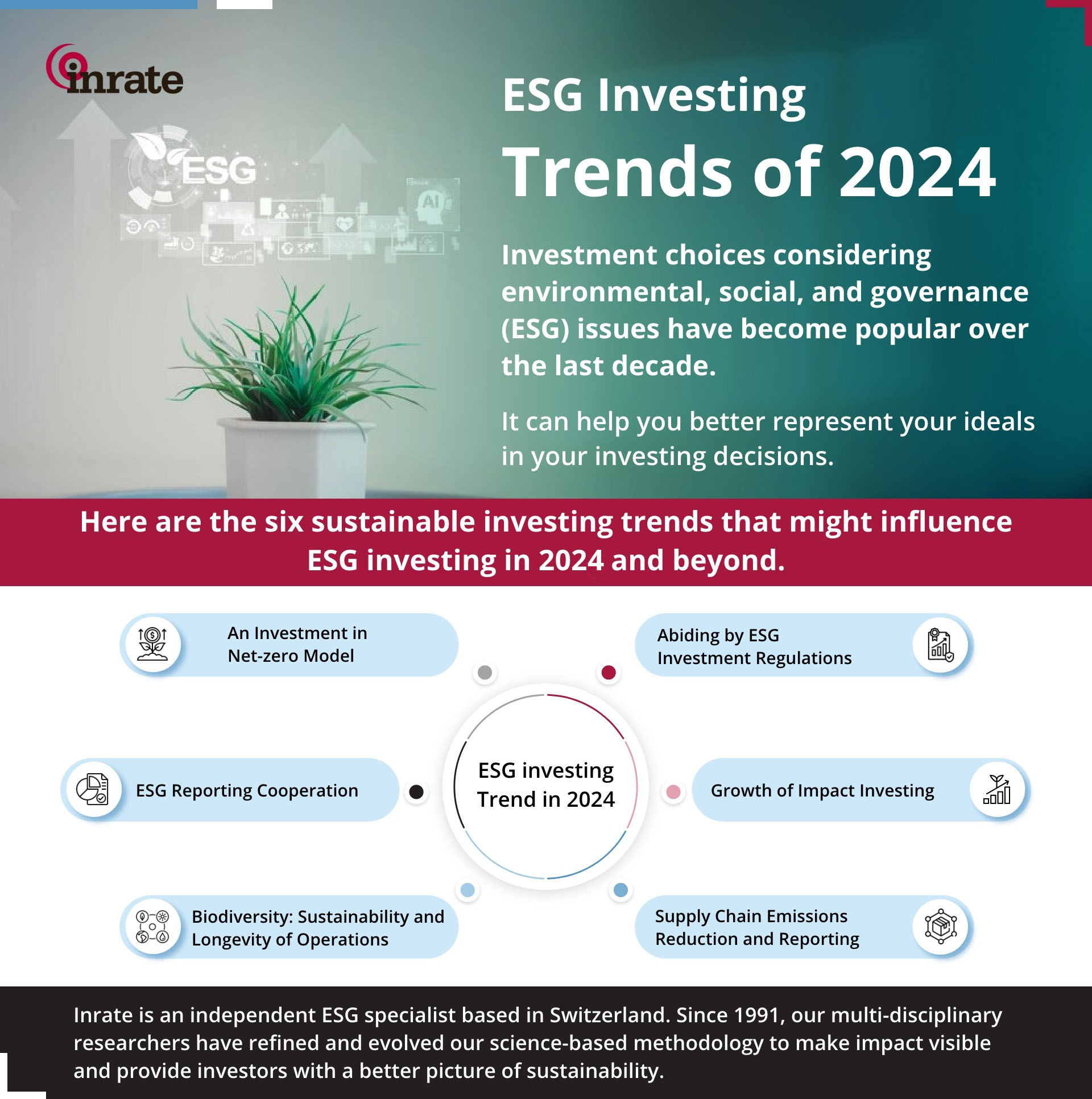Ethical investors, billion-dollar corporations, enormous private equity firms, and most recently, the Securities and Exchange Commission (SEC) and International Sustainability Standards Board (ISSB) have all embraced ESG investing as a market trend.
During the COVID-19 pandemic, ESG investing reached record highs, despite widespread predictions that it would only last through the next fiscal year. But even in uncertain global economic conditions, ESG has become a topic of everyday conversation. By 2025, according to Bloomberg Terminal, a third of AUM will be made up of ESG assets, with a $53 trillion valuation. ESG will be a standard topic of discussion in corporate discourse starting in 2024 and beyond.
What may ESG investors expect in the near future? This blog will review the top ESG investing trends to look out for in 2024.
Top ESG Investing Trends 2024
Investment choices considering environmental, social, and governance (ESG) issues have become popular over the last decade. It can help you better represent your ideals in your investing decisions. Here are the six sustainable investing trends that might influence ESG investment trends in 2024 and beyond.

1. An Investment in Net-zero Model
A record number of international governments and significant corporations announced plans to achieve net zero emissions by 2050, paving the way for a bright future in which the use of fossil fuels and greenhouse gases by businesses would be minimal or nonexistent, and they would be dependent on renewable energy. However, corporate pledges usually lack interim emission reduction objectives or strategies to reduce indirect supply chain emissions because the deadline is close to a quarter of a century away.
Stakeholders and investors are taking note of this mismatch and demanding corporations create tangible, short-term strategies to track the advancement of their ESG pledges and goals. Governments and businesses must provide credible, attainable near-term signposts on their route to decarbonization for long-term stakeholders, thereby removing any chance for companies to commit to unachievable ESG efforts without intending to follow through.
2. Abiding by ESG Investment Regulations
The C-Suite leadership is taking action to make sure that their corporate operations appropriately reflect their commitments when new jurisdictions on ESG stock labeling, trading, and selling arise. Based on the “G” pillar, boards and committees are being established to define governance structure and policies, in line with trends in ESG investing, and provide a framework for monitoring accountability and strategic focus. These boards and committees will help organizations better understand and observe how well they are positioned for the goals they have set.
Executives make sure that stakeholders are informed of their initiatives. Companies’ advancement along an ESG maturity model, which is increasingly integrated into their core business strategy and risk program, and their definition of how the board supervises such ESG initiatives, are likely the causes of this development.
3. ESG Reporting Cooperation
Companies that compare data on ESG progress, risks and opportunities are particularly affected by the absence of reporting standards for ESG measurements.
A standardized method of assessing a company’s promise will assist investors in comprehending the many ESG elements and indicators shared with asset managers as legislation on reporting requirements and transparency slowly evolve to govern how firms may handle ESG.
The ESG data businesses must collect, publish, and use information to pique investor interest; this will evolve as rules change. Hence, organizations must ensure that all employees engaged in creating ESG reports take part in the internal collaborative, centralized reporting model adopted and understand their position.
Companies are communicating how ESG review panel board members will need the proper reporting tools and, more importantly, clear and consistent lines of communication by implementing education initiatives across teams. Everyone seated at the boardroom table, whether an ESG leader or not, has a role in maximizing the advantages of being a transparent firm.
4. Growth of Impact Investing
Investors’ perceptions of ESG may still be unclear. While the approach presents itself as an investment for the common good, it is a framework to aid investors in assessing the risk associated with a company’s ESG policies. ESG investors select firms with higher scores because they think doing so would lower their total portfolio risk, not necessarily because it will benefit the environment.
Impact investing, in the context of esg investing trends 2024, is becoming more and more popular as a clearer, more deliberate method of developing a portfolio that benefits people and the environment without losing financial returns as the industry struggles with how to course-correct on ESG. A thorough and consistent assessment approach is used in impact investing to give investors clarity and confidence about how their investments can deliver meaningful positive results.
5. Biodiversity: Sustainability and Longevity of Operations
Investors are increasingly interested in biodiversity because of the significant risks and opportunities associated with biodiversity loss and conservation. Biodiversity loss can have a significant negative impact on the long-term sustainability of companies, especially those operating in sectors that rely on natural resources, such as agriculture, forestry, fisheries, and tourism. The degradation of ecosystems and the loss of biodiversity can lead to reduced productivity, supply chain disruptions, reputational damage, regulatory risks, and increased costs related to environmental liabilities.
6. Supply Chain Emissions Reduction and Reporting
Since supply chains may be responsible for more than 90% of a company’s greenhouse gas emissions, it is impossible to overstate their significance in ESG. The majority of these emissions are caused by the source. Thus, expenditure control should be a primary priority for businesses that place a high value on supply chain sustainability.
ESG is aligned with the strategic selection of partners and goods with smaller emissions footprints, but what may be even more significant is that reporting and disclosing these data is essential for building trust with stakeholders. And to do this, increasingly more companies are embracing digital transformation by implementing business networks and intelligent spending technologies.
Future compliance and audit requirements will probably follow as ESG investing becomes more crucial to a company’s survival in our unstable market, making digitalization necessary to scale resources and outcomes throughout the enterprise, a key consideration in ESG investing trends 2024. Moreover, businesses that have embraced digital transformation in their processes have already seen financial gains.

In Conclusion,
As more funds look for investments with positive social impacts and profit potential, ESG investment trends are becoming a more powerful influence in the capital markets. Businesses that uphold strict environmental standards and pay their employees reasonably benefit society and may attract additional investors
Keeping up with current trends in ESG investing and disclosure requirements is essential for the business survival of public and private organizations as new rules are continuously being developed to combat greenwashing, deceptive schemes, and other ESG hazards held by private equity funds. It’s a necessity that requires a tool that continually gathers the most up-to-date information from the industry while cutting through the noise that keeps you from the solutions you seek. ESG Data Solutions by Inrate offers all of that and more.





